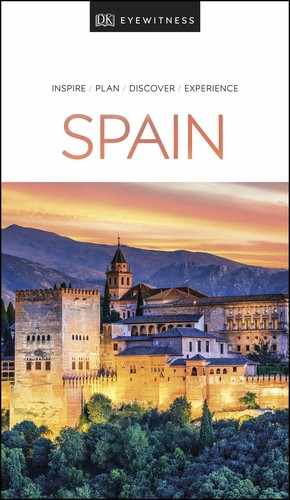Experience More

t Craggy, tree-clad hills around the ancient gold mines near Las Médulas
This northwestern region of León province was at one time the bed of an ancient lake. Sheltered by hills from the worst extremes of Central Spain’s climate, its sun-soaked, alluvial soils make for fertile orchards and vineyards. Over the centuries, the area has also yielded rich mineral pickings including coal, iron and gold. Nowadays, El Bierzo is a popular destination for walkers, with many routes and picnic spots.
In the eastern section, you can trace the course of the old Camino de Santiago through the Montes de León, past the pilgrim church and medieval bridge of Molinaseca. Turning off the road at the remote village of El Acebo, you pass through a deep valley where there are signs pointing to the Herrería de Compludo, a water-powered 7th-century ironworks. The equipment still works and is demonstrated regularly.
The Lago de Carucedo, to the southwest of Ponferrada, is an ancient artificial lake. It acted as a reservoir in Roman times, a by-product of a vast gold-mining operation. Using slave labour, millions of tonnes of alluvium were washed from the hills of Las Médulas by a complex system of canals and sluice gates. The ore was then panned, and the gold dust collected on sheep’s wool. It is estimated that more than 500 tonnes of precious metal were extracted between the 1st and 4th centuries AD. These ancient workings lie within a memorable landscape of wind-eroded crags, and hills pierced by tunnels and colonized by gnarled chestnut trees. The goldmines of Las Médulas are now a UNESCO World Heritage Site. You can best appreciate the area from a viewpoint at Orellán, which is reached via a rough, steep track.
North of the A6 highway lies the Sierra de Ancares, a wild region of rounded, slate mountains marking the borders with Galicia and Asturias. Part of it forms a nature reserve, Reserva Nacional de los Ancares Leoneses. The heathland is home to deer, wolves and brown bears.
Several villages in the hills contain pallozas – primitive, pre-Roman stone dwellings. One of the most striking collections can be found in isolated Campo del Agua, in the west.
"
Herrería de Compludo
⌂ Compludo § 661 250 756 # 10am–2pm & 4–8pm Wed–Sun & public hols
" '
Las Médulas
# 11am–2pm & 4–8pm daily (Oct–Mar: to 6pm) ¢ Public hols ∑ espaciolasmedulas.es
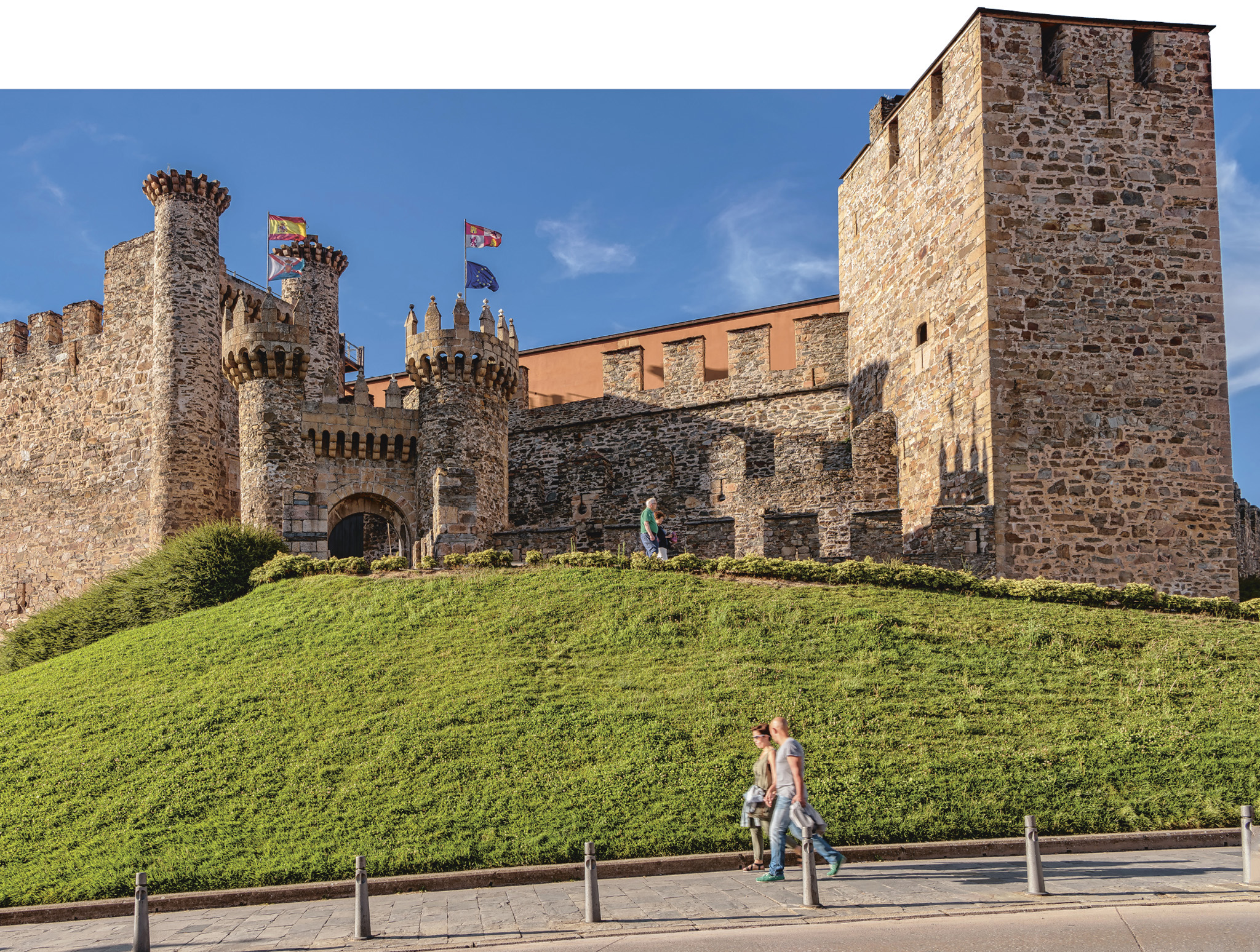
t The medieval Knights Templar castle, a major landmark at Ponferrada
A medieval bridge reinforced with iron (pons ferrata), erected for the benefit of pilgrims on their way to Santiago de Compostela, gave this town its name. Today, prosperous from both iron and coal deposits, Ponferrada has expanded into a sizable town.
Most of the town’s attractions are confined to the small old quarter. Ponferrada’s majestic castle was constructed between the 12th and 14th centuries by the Knights Templar to protect pilgrims. During the Middle Ages it was one of the largest fortresses standing in northwest Spain.
Standing on the main square is the Baroque ayuntamiento. One entrance to the square, one of the gateways of the medieval wall, is straddled by a tall clock tower. Nearby is the Renaissance Basílica de la Virgen de la Encina. The older Iglesia de Santo Tomás de las Ollas is hidden away in the town’s village-like northern suburbs. Mozarabic, Romanesque and Baroque elements combine in the architecture of this simple church. The 10th- century apse has beautiful horseshoe arches. Ask at the nearest house for the key. The neighbour will open it for you.
A drive through the idyllic Valle de Silencio (Valley of Silence), south of Ponferrada, follows a poplar-lined stream past several bucolic villages. The last and most beautiful of these is Peñalba de Santiago. Its 10th-century Mozarabic church has horseshoe arches above its double portal.

Hidden Gem
Wireless Technology
Radio fans will enjoy Ponferrada’s Museo de la Radio (Calle Gil y Carrasco 7), which displays over 200 old sets belonging to Luis del Olmo (b 1937), a celebrated radio presenter in Spain. It’s fascinating to see how radio has developed over the years.
Emblazoned mansions line the ancient streets of this delightful town. The solid, early 16th-century, drum-towered castle is still inhabited. Near the Plaza Mayor a number of imposing churches and convents, such as San Nicolás el Real, compete for attention. Particularly worth seeing are the fine sculptures adorning the north portal of the Iglesia de Santiago. At the church’s Puerta del Perdón (Door of Mercy), pilgrims who were too weak to make the final gruelling hike across the hills of Galicia could obtain dispensation. Also sample the local speciality, cherries in aguardiente, a spirit.
One of the finest views over El Bierzo is from Corullón, to the south. This village with grey stone houses is set above the broad, fertile basin of the Río Burbia where vines flourish. Two churches, the late 11th-century San Miguel and the Romanesque San Esteban, are worth a visit. Don’t miss the Benedictine monastery at Carracedo del Monasterio. Founded in 990, it was once the most powerful religious community in El Bierzo.

t The 17th-century façade of San Nicolás el Real in Villafranca del Bierzo
Iglesia de Santiago
⌂ Calle Camino Santiago 18 # 1 Jul–mid-Sep: 10:30am–1:30pm & 5–8pm Tue–Sun ¢ Mid-Sep–Jun
EXPERIENCE Castilla y León
|
Stay Hostal Puerta del Alcázar In front of the city walls, this budget hotel is fairly basic but it’s set in an unbeatable location. The terrace has views over the cathedral. ⌂ Calle San Segundo 38, Ávila ∑ puertadelalcazar.com ¡¡¡ Parador de Zemora Suits of armour and tapestries adorn the interior at this parador set in a medieval palace. But there are also modern touches, including a big outdoor pool. ⌂ Plaza Viriato 5, Zamora ∑ parador.es ¡¡¡ |
The Roman town of Asturica Augusta was a strategic halt on the Vía de la Plata (Silver Road), a Roman road linking Andalucía and northwest Spain. Later it came to form a stage on the pilgrimage route to Santiago.
Soaring above the ramparts in the upper town are Astorga’s two principal monuments, the cathedral and the Palacio Episcopal. The cathedral was built between the 15th and 18th centuries and displays a variety of architectural styles ranging from its Gothic apse to the effusive Baroque of its two towers, which are carved with various biblical scenes. The gilt altarpiece by Gaspar Becerra is a masterpiece of the Spanish Renaissance. Among the many fine exhibits in the cathedral’s museum are the 10th-century carved casket of Alfonso III the Great, the jewelled Reliquary of the True Cross and a lavish silver monstrance studded with enormous emeralds.
Opposite the cathedral is a fairy-tale building of multiple turrets and quasi-Gothic windows. The unconventional Palacio Episcopal is now known as the Palacio de Gaudí. It was designed by the Modernista architect for the incumbent bishop, a fellow Catalan, after a fire in 1887 had destroyed the previous building. Its bizarre appearance as well as its phenomenal cost so horrified the diocese that no subsequent bishops ever lived in it.
Today it houses an assembly of medieval religious art devoted to the history of Astorga and the Camino de Santiago. Roman relics, including coins found in the Plaza Romana, are evidence of Astorga’s importance as a Roman settlement. The interior is decorated with ceramic tiles and stained glass.
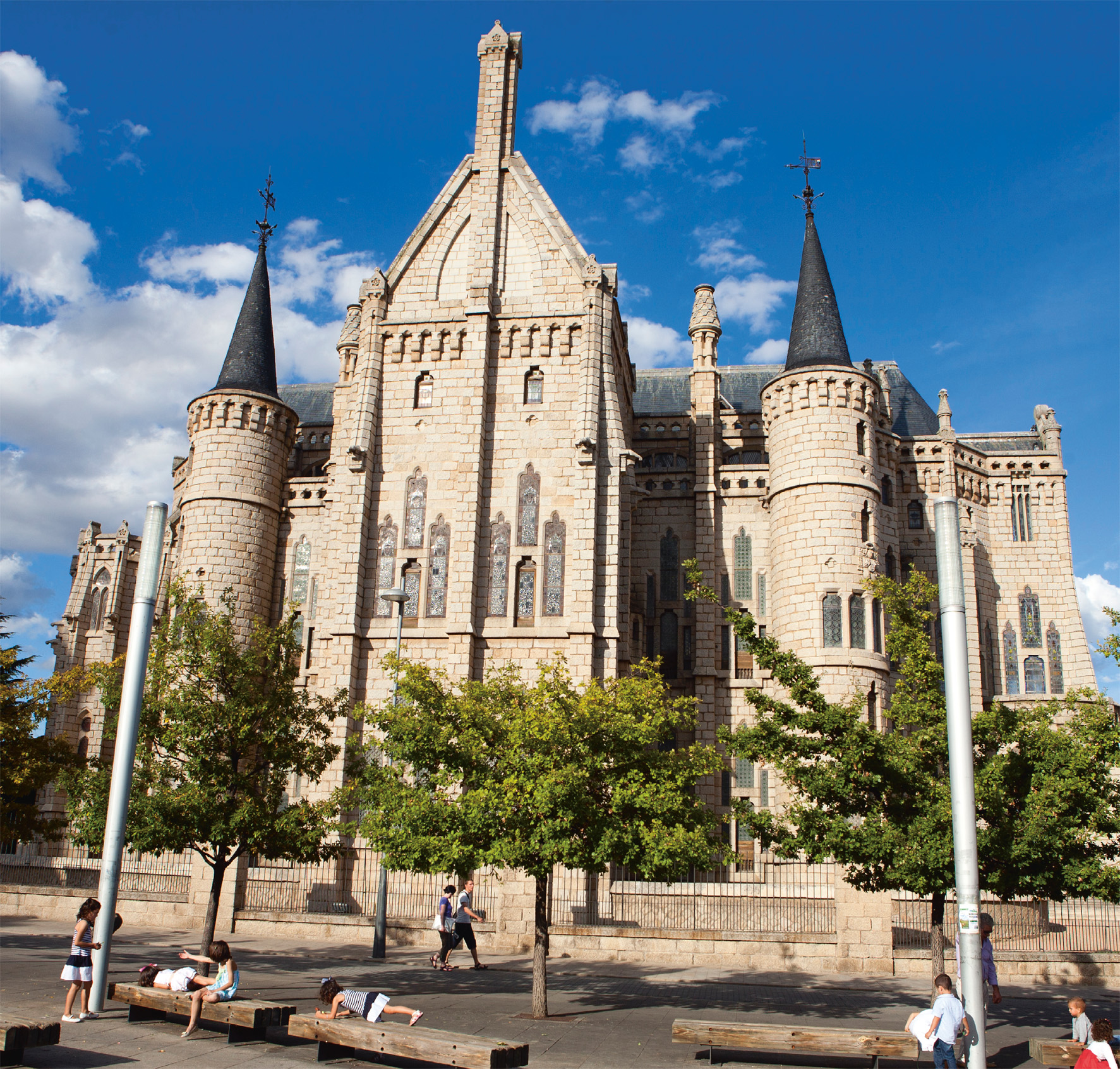
t A Gaudí masterpiece of turrets and spires, the Palacio de Gaudí at Astorga
"
Palacio de Gaudí
⌂ Plaza Eduardo de Castro 15 # May–Oct: 10am–2pm & 4–8pm daily; Nov–Apr: 10:30am–2pm & 4–6:30pm Tue–Sun ¢ 1 & 6 Jan, 25 Dec ∑ palaciodegaudi.es
This complex of limestone caves – technically a single cave with three separate entrances – is directly beneath the village of Valporquero de Torío. The caves were formed in the Miocene period between 5 and 25 million years ago. Severe weather conditions in the surrounding mountains make the caverns inaccessible between December and Easter. Less than half of the huge system, which stretches 3,100 m (10,200 ft) under the ground, is open to the public. Guided tours take parties through an impressive series of galleries in which lighting picks out the beautiful limestone concretions. Iron and sulphur oxides have tinted the rocks many subtle shades of red, grey and black. The vast Gran Rotonda, covering an area of 5,600 sq m (18,350 sq ft) and reaching a height of 20 m (65 ft), is the most stunning.
As the interior is cold, and the surface often slippery, it is advisable to wear warm clothes and sturdy shoes.
EXPERIENCE Castilla y León
The Maragatos

t TRADITIONAL MARAGATO COSTUME
Astorga is the main town of the Maragatos, an ethnic group of unknown origin, thought to be descended from 8th-century Berber invaders. By marrying only among themselves, they managed to preserve their customs through the years and keep themselves apart from the rest of society. But the demise of their traditional trade of mule-driving changed their way of life and the Maragatos have adapted to contemporary life, although their gastronomy and craftwork still survive.
Despite its lonely setting – stranded on the country’s western marches miles from anywhere – this lovely old town, with its golden stone buildings, is well worth a detour. Its frontier location inevitably gave rise to fortification, and its robust 14th-century castle is now an atmospheric parador. The prosperous 15th and 16th centuries were Ciudad Rodrigo’s heyday. During the War of Independence, the city, then occupied by the French, was besieged for two years before falling to the Duke of Wellington’s forces.
The cathedral’s belfry still bears the marks of shellfire from the siege. The exterior has a shapely curved balustrade and accomplished portal carvings. Inside, it is worth seeing the cloisters and the choir stalls, carved with lively scenes by Rodrigo Alemán. Within the adjacent 16th-century Capilla de Cerralbo (open to tourists only in summer) is a 17th-century altarpiece. Off the chapel’s south side is the arcaded Plaza del Buen Alcalde.
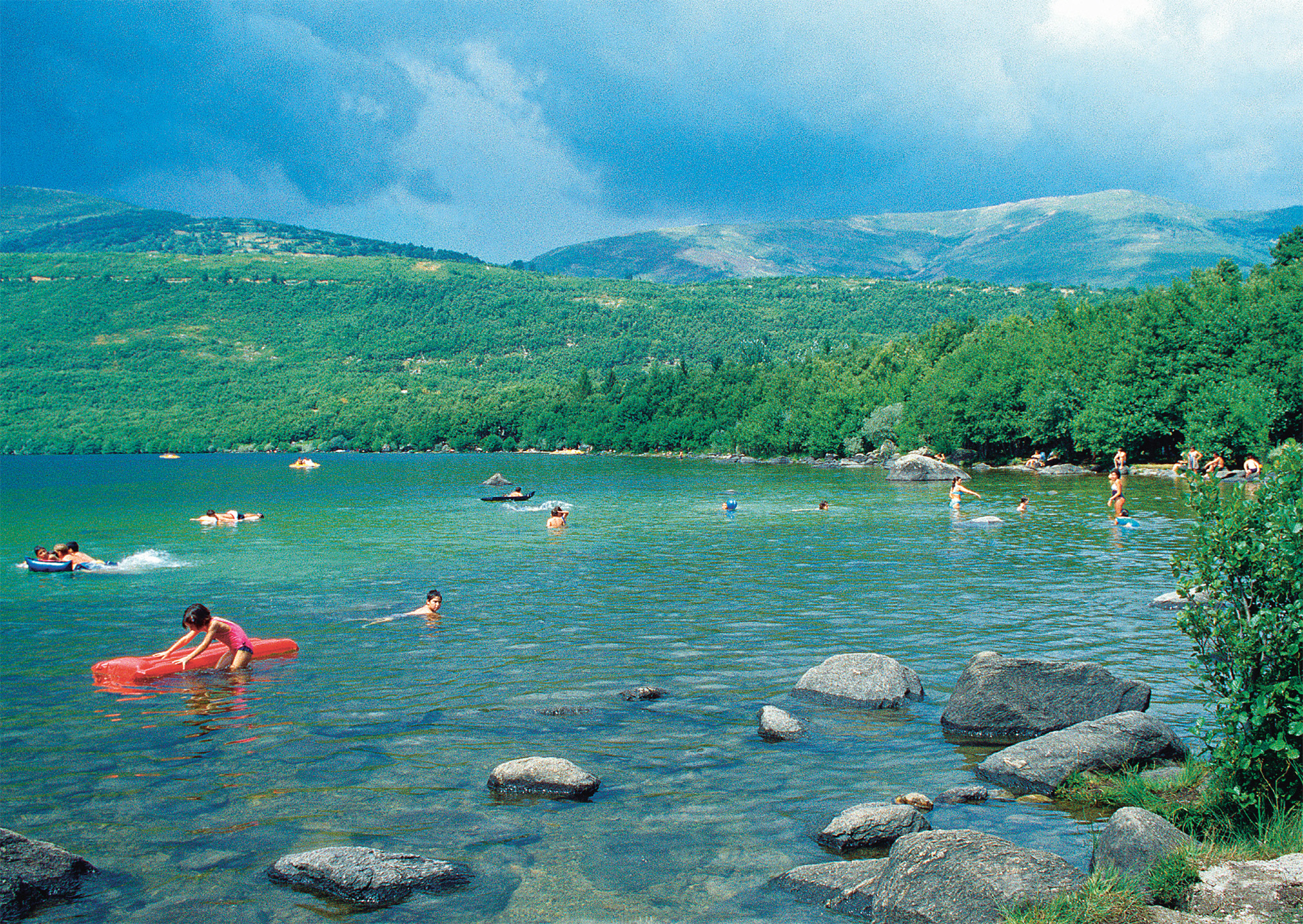
t Holiday-makers bathing in Lago de Sanabria at Peubla de Sanabria
This attractive old village lies beyond the undulating broom and oak scrub of the Sierra de la Culebra. A steep cobbled street leads past stone and slate houses with huge, overhanging eaves and walls bearing coats of arms, to a hilltop church and castle.
The village has become the centre of a popular inland holiday resort based around the largest glacial lake in Spain, the Lago de Sanabria, now a nature park. Among the many activities available are fishing, walking and water sports.
Most routes beckon visitors to Ribadelago, but the road to the quaint hill village of San Martín de Castañeda gives better views. There’s a small visitors’ centre for the nature reserve in San Martín’s restored monastery. The village is very traditional – you may see cattle yoked to carts, and women dressed completely in black.
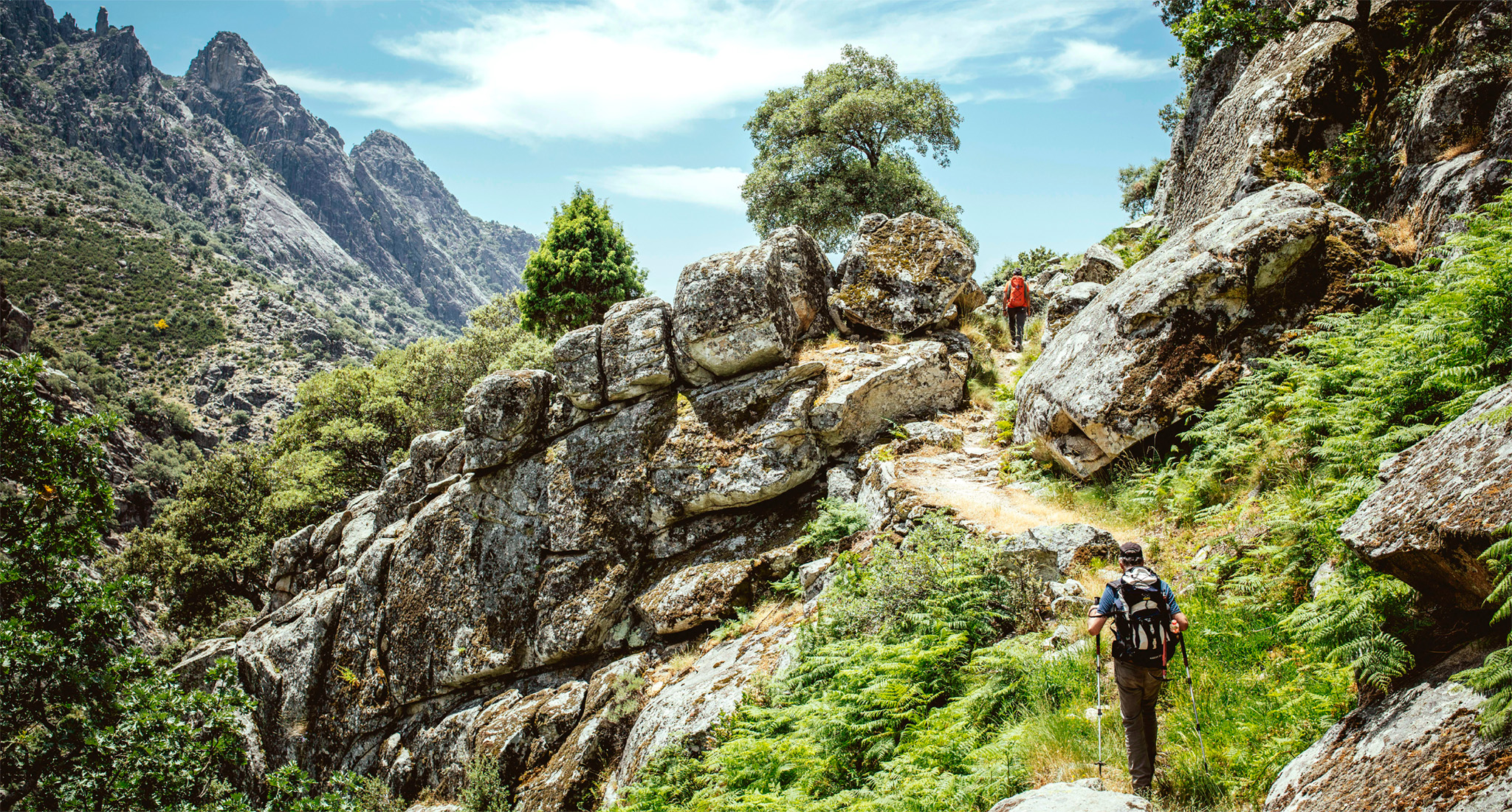
t Hikers tackling the rocky landscape of the dramatic Sierra de Gredos
This great mountain range has abundant wildlife. Tourism here isn’t a recent phenomenon – Spain’s first parador opened in Gredos in 1928 and some parts of the sierra have been developed to cater for weekenders who come here to ski, fish, hunt or hike. Despite this, there are many traditional villages off the beaten track. The slopes on the south side of the range, extending into Extremadura, are fertile and sheltered, with pinewoods, and apple and olive trees. The northern slopes, in contrast, have a covering of scrub and a scattering of granite boulders.
A single main road, the N502, crosses the centre of the range via the Puerto del Pico, a pass at 1,352 m (4,435 ft), leading to Arenas de San Pedro, the largest town of the Sierra de Gredos. Situated on this road is the castle of Mombeltrán, built at the end of the 14th century.
Near Ramacastañas, south of the town of Arenas de San Pedro, are the limestone caverns of the Cuevas del Águila.
The sierra’s highest summit, the Pico Almanzor dominates the west. Around it lies the Reserva Nacional de Gredos, protecting the mountain’s wildlife. Near El Tiemblo, in the east, stand the Toros de Guisando, four stone statues resembling bulls, believed to be of Celtiberian origin.
Did You Know?
Pico Almanzor in the Sierra de Gredos is 2,502 m (8,500 ft) tall.

Insider Tip
Water Show
Time your visit to La Granja de San Ildefonso with its fountains. Three times a year, on 30 May, 25 July and 25 August, all of the jets are set in motion at once, and between May and July four fountains run every Wednesday and Saturday at 5:30pm and Sunday at 1pm.
This royal pleasure palace, a project launched by Felipe V in 1720, is set against the Sierra de Guadarrama, on the site of the old Convento de Jerónimos.
A guided tour meanders through countless impressive salons decorated with ornate objets d’art and Classical frescoes against settings of marble, gilt and velvet. Huge glittering chandeliers, produced locally, hang from the ceiling. In the private apartments there are superb tapestries. The church is decorated in lavish high Baroque style, and the Royal Mausoleum contains the tomb of Felipe V and his queen.
Out in the gardens, stately chestnut trees, manicured hedges and statues frame a complex series of pools that are enhanced with fountains.
The Real Fábrica de Cristales de La Granja (Royal Glass Factory), 11 km (7 miles) southeast, is also worth a visit. Founded in 1727 by Felipe V of Spain, it still produces high-quality pieces of crystal, and it includes a glass museum with glass-blowing demonstrations.
In Roman times, Zamora was on the Vía de la Plata, and during the Reconquest was fought over fiercely. The city has expanded beyond its original boundaries, but the old quarter contains a wealth of Romanesque churches.
The ruins of the city walls, built by Alfonso III in 893, are pierced by the Portillo de la Traición (Traitor’s Gate), through which the murderer of Sancho II passed in 1072. The parador is in a 16th-century palace with a Renaissance courtyard.
Two other palaces, the Palacio de los Momos and the Palacio del Cordón, have ornately carved façades and windows. Zamora’s most important monument is its cathedral, a 12th-century structure built in Romanesque style but with a number of later Gothic additions. The building’s most eye-catching feature is its striking, scaly, hemispherical dome. Inside, there are superb iron grilles and Mudéjar pulpits surround Juan de Bruselas’ 15th-century choir stalls. The allegorical carvings of nuns and monks on the misericords and armrests were once considered risqué. The museum, off the cloisters, has a collection of 15th- and 16th-century Flemish tapestries.
Another reason for visiting Zamora is for its lively Easter Week celebrations, when elaborate pasos (sculpted floats) are paraded in the streets.
EXPERIENCE Castilla y León
|
Drink Cinco Sentidos This cosy café is the perfect place to take a break. It sells “healthy” treats, so you won’t feel guilty for ordering a snack. ⌂ Calle Juan de Lama 13, Ponferrada § 987 41 59 63 Cafeteria Hotel Gaudí As you might expect from the name, this hotel café offers fantastic views of the Palacio de Gaudí. ⌂ Glorieta Eduardo de Castro 6, Astorga § 987 61 56 54 Bar Alfres This simple bar serves all the usual tipples, accompanied by the city’s best pinchitos (kebabs) – the perfect accompaniment for your drink. ⌂ Calle Santa Teresa 14, Zamora § 647 15 60 66 |

t River flowing through the Parque Natural de las Hoces del Duratón, Sepúlveda
On a slope above the Río Duratón, this picturesque town offers views of the Sierra de Guadarrama. Parts of its medieval walls and castle survive. Of its several Romanesque churches, the Iglesia del Salvador, behind the main square, is notable for possessing one of the oldest atria in Spain (1093).
Winding through a canyon haunted by griffon vultures is the Río Duratón, 7 km (4 miles) west of Sepúlveda. This extensive area of striking beauty has been designated the Parque Natural de las Hoces del Duratón.
Ayllón, 45 km (28 miles) northeast of Sepúlveda, has an arcaded main square and the Plateresque Palacio de Juan de Contreras of 1497.
Did You Know?
Relics of Santa Teresa de Ávila are found in Paris, Lisbon, Rome and all over Spain.
At 1,131 m (3,710 ft) above sea level, Ávila de los Caballeros (“of the Knights”) is the highest provincial capital in Spain. In winter access roads can be blocked with snow.
The centre of the city is encircled by the finest-preserved medieval walls in Europe. Built in the 11th century, the walls are over 2 km (1 mile) long. They are punctuated by 88 sturdy turrets, on which storks can be seen nesting. The ground falls away very steeply from the walls on three sides, making the city practically impregnable, but the east side, however, is relatively flat, and therefore had to be fortified more heavily. This section of the wall is guarded by the most impressive of the city’s nine gateways, the Puerta de San Vicente.
The apse of the cathedral also forms part of the walls. The cathedral’s war-like (and unfinished) exterior is decorated with beasts and scaly wild men, while the interior is formed of an unusual mottled red and white stone. Finer points to note are the carvings on the retrochoir and, in the apse, the tomb of a 15th-century bishop known as El Tostado, “the Tanned One”, because of his dark complexion.
Many churches and convents in Ávila are linked to St Teresa, who was born in the city. The Convento de Santa Teresa was built on the site of her home within the walls and she also lived for over 20 years in the Monasterio de la Encarnación outside the walls. There is even a local sweetmeat, yemas de Santa Teresa, named after her.
The Basílica de San Vicente, also just outside the eastern walls, is Ávila’s most important Romanesque church, distinguished by its ornamented belfry. It was begun in the 11th century but has some Gothic features which were added later. The west doorway is often compared to the Pórtico da Gloria of Santiago Cathedral. Inside, the carved tomb of St Vincent and his sisters depicts their hideous martyrdom in detail. Another Romanesque-Gothic church worth seeing is the Iglesia de San Pedro. Some way from the centre is the Real Monasterio de Santo Tomás, which boasts three cloisters. The middle one, carved with the yoke and arrow emblem of the Catholic Monarchs, is the most beautiful. The last cloister leads to a museum displaying chalices and processional crosses. The church contains the tomb of Prince Juan, the only son of Fernando and Isabel. In the sacristy lies another historic figure: Tomás de Torquemada, head of the Inquisition.
In Ávila, you may see groups of tunas – students dressed in traditional costume walking the town’s streets while singing and playing guitars.
"
Walls
# 10am–8pm Tue–Sun ∑ muralladeavila.com
The aristocratic little town of Pedraza de la Sierra is perched high over rolling countryside. Within its medieval walls, old streets lead to the porticoed Plaza Mayor. The huge castle, standing on a rocky outcrop, was owned by Basque artist Ignacio Zuloaga (1870–1945). The castle museum shows some of his works. On the first and second Saturdays in July, concerts are held in the Plaza Mayor.
EXPERIENCE Castilla y León
St Teresa de Ávila
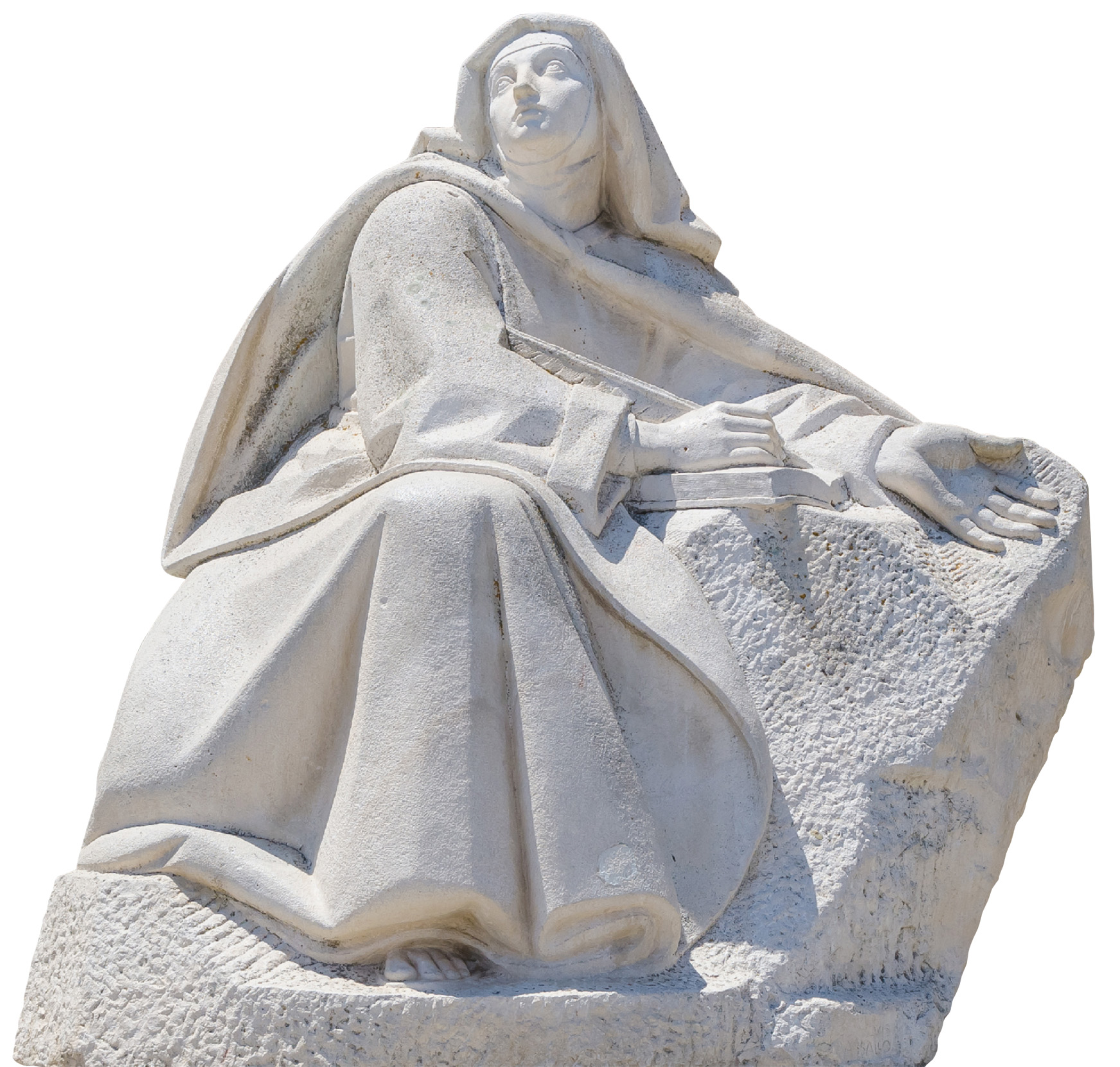
Teresa de Cepeda y Ahumada (1515–82) was one of the Catholic Church’s greatest mystics and reformers. Aged seven, she ran away from home in hope of achieving martyrdom at the hands of the Moors, but was captured by her uncle on the outskirts of the city. She became a nun at 19 but rebelled against her order. From 1562, when she founded her first convent, she travelled around Spain with her disciple, St John of the Cross, founding more convents for the followers of her order, the Barefoot Carmelites. Her remains are in Alba de Tormes near Salamanca.

t Massive defensive walls of the 15th-century Castillo de Coca
Built in the late 15th century for the influential Fonseca family, Coca castle is one of Castilla y León’s most memorable fortresses. Unlike the region’s other castles, it was used more as a residential palace than a defensive fortress, although its turrets and battlements are a fine example of Mudéjar military architecture. The complex moated structure comprises three concentric walls around a massive keep. It is now a forestry school, which features a display of Romanesque woodcarvings.
The 14th-century castle of Arévalo in Ávila province, located 26 km (16 miles) southwest, is where Isabel I spent her childhood. The porticoed Plaza de la Villa is surrounded by several attractive half-timbered houses.
Located at the confluence of the Río Esgueva and Río Pisuerga, Valladolid is a sprawling and industrialized city, but it still has some of Spain’s best Renaissance art and architecture.
The city has had many famous inhabitants. Fernando and Isabel were married in the Palacio Vivero in the city in 1469 and, following the completion of the Reconquest in 1492, they made Valladolid their capital. Columbus died here, alone and forgotten, in 1506. Felipe II was born in the Palacio de los Pimentel in 1527 and José Zorrilla, who popularized the legendary Don Juan in his 1844 play, was born here in 1817. But perhaps the city’s most famous inhabitant is the author of Don Quixote, who lived in the Casa de Cervantes from 1603 to 1606.
Valladolid’s has many beautiful churches. The Iglesia de San Pablo has a spectacular façade, embellished with angels and coats of arms in Plateresque style. Santa María la Antigua has Romanesque belfry and the Iglesia de Las Angustias houses Juan de Juni’s fine sculpture of the Virgen de los Cuchillos (Virgin of the Knives).
Work started on the unfinished cathedral in 1580 by Felipe II’s favourite architect, Juan de Herrera, but lost momentum over the centuries. Churrigueresque flourishes on the façade contrast to the sombre interior, whose only flamboyance is a Juan de Juni altarpiece. The Museo Diocesano inside, however, contains some fine religious art and sculpture.
Housed in the 15th-century Colegio de San Gregorio, the Museo Nacional de Escultura houses mainly religious sculptures from the 13th to 18th centuries. They include Juan de Juni’s emotive depiction of the burial of Christ and Recumbent Christ by Gregorio Fernández. An Alonso Berruguete altarpiece and walnut choir stalls by Diego de Siloé are among the other fine works to be found here. The building, too, is impressive, particularly the Plateresque staircase, the chapel by Juan Güas, and the patio of twisted columns and delicate basket arches. The façade is a fine example of Isabelline sculpture, portraying a melee of naked children scrambling about in thorn trees.
Inside the former Monastery of San Benito, the Patio Herreriano Museo de Arte Contemporáneo Español holds a private collection of contemporary Spanish art. Among the 800 works are masterpieces by Joan Miró, Eduardo Chillida, Antoni Tàpies and Miquel Barceló.
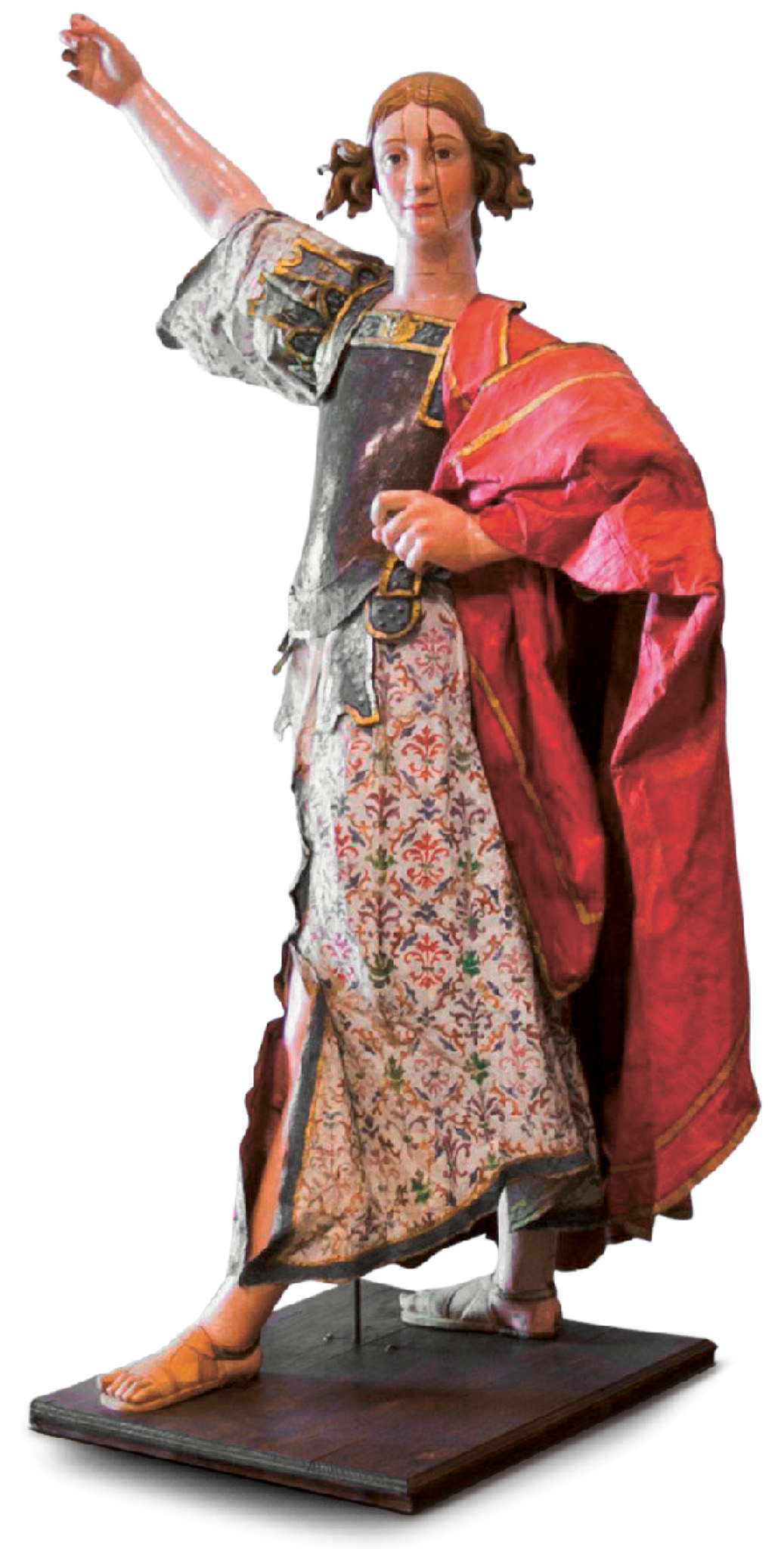
t Wooden sculpture at the Museo Nacional de Escultura in Valladolid
"
Casa de Cervantes
⌂ Calle Rastro s/n # 9:30am–3pm Tue–Sun ¢ Public hols ∑ museocasacervantes.mcu.es
" '
Cathedral
⌂ Calle Arribas 1 # 11am–6pm Tue–Thu, 11am–9pm Sat, 11am–2pm Sun ∑ catedral-valladolid.com
"
Museo Nacional de Escultura
⌂ Calle Cadenas de San Gregorio 1 # 10am–2pm & 4–7:30pm Tue–Sun ∑ museoescultura.mcu.es
"
Patio Herreriano Museo de Arte Contemporáneo Español
⌂ Calle Jorge Guillén 6 # 11am–2pm & 5–8pm Tue–Fri, 11am–8pm Sat, 11am–3pm Sun ¢ 1 Jan, 25 Dec ∑ museopatioherreriano.org

Picture Perfect
Life in Squares
Valladolid’s Plaza Mayor is one of Spain’s most splendid, but unlike most others, it is not normally thronging with tourists. The porticoed terraces and elegant buildings make for lovely shots.
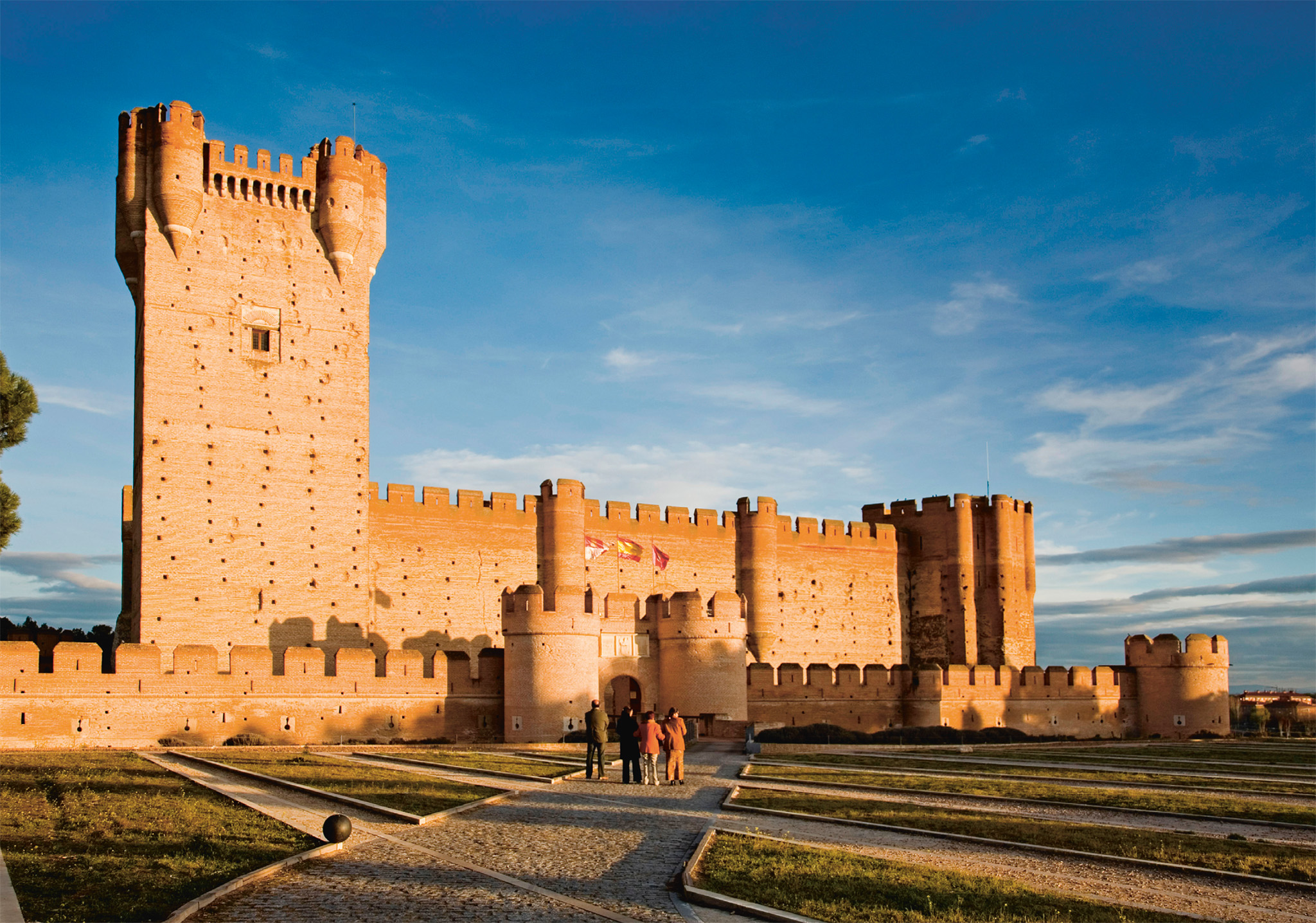
t The immense Mudéjar exterior of the Castillo de la Mota at Medina del Campo
Medina became wealthy in medieval times on the proceeds of huge sheep fairs and is still an important agricultural centre today. The vast brick Gothic-Mudejár Castillo de la Mota, on its outskirts, began as a Moorish castle but was rebuilt in 1440. The town transferred the castle’s ownership to the Crown in 1475. Isabel I and her daughter Juana “la Loca” (“the Mad”) both stayed here. Later, it served as a prison – Cesare Borja was incarcerated here from 1506 to 1508. In a corner of the Plaza Mayor stands the modest house where Isabel died in 1504.
Towering over the plains, some 25 km (16 miles) to the south of Medina del Campo, are the walls of Madrigal de las Altas Torres, which owes its name to the hundreds of bastions that marked the old wall; only 23 remain. In 1451 Isabel was born here in a palace that later became the Monasterio de las Agustinas in 1527.
" '
Castillo de la Mota
# Summer: 11am–2pm & 4–7pm Mon–Sat, 11am–2pm Sun; winter: 11am–2pm & 4–6pm Mon–Sat, 11am–2pm Sun ∑ castillodelamota.es
This pleasant town is known for being where the historic treaty between Spain and Portugal was signed in 1494, which divided the lands of the New World. A fateful oversight by the Spanish map-makers left the immense prize of Brazil to Portugal. The Monasterio de Santa Clara was constructed by Alfonso XI around 1340 and then converted by his son Pedro the Cruel into a stunning residence for his mistress, María de Padilla. Pining for her native Andalucía, she had the convent decorated with fine Moorish arches, baths and tiles.
Located in the old quarter, the Iglesia de San Antolín now houses religious art, with paintings as well as a collection of liturgical objects.
"
Monasterio de Santa Clara
⌂ Calle Alonso Castillo Solorzano # 10am–2pm & 4–6:30pm Tue–Sat, 10:30am–3pm Sun ∑ patrimonionacional.es
"
Iglesia de San Antolín
⌂ Calle Postigo § 983 77 09 80 # 11:30am–1:30pm & 4:30–6:30pm Tue–Sun
EXPERIENCE Castilla y León
|
Eat Restaurante Alcaravea The menu offered at this warm, ochre-walled restaurant features local recipes that have been passed down over the years. ⌂ Plaza de la Catedral 15, Ávila § 920 22 66 00 ¡¡¡ La Parrilla de San Lorenzo Located in the basement of a monastery, this traditional grill is a treasure trove of antiques. ⌂ Calle Pedro Niño 1, Valladolid ∑ laparrilladesanlorenzo.es ¡¡¡ |
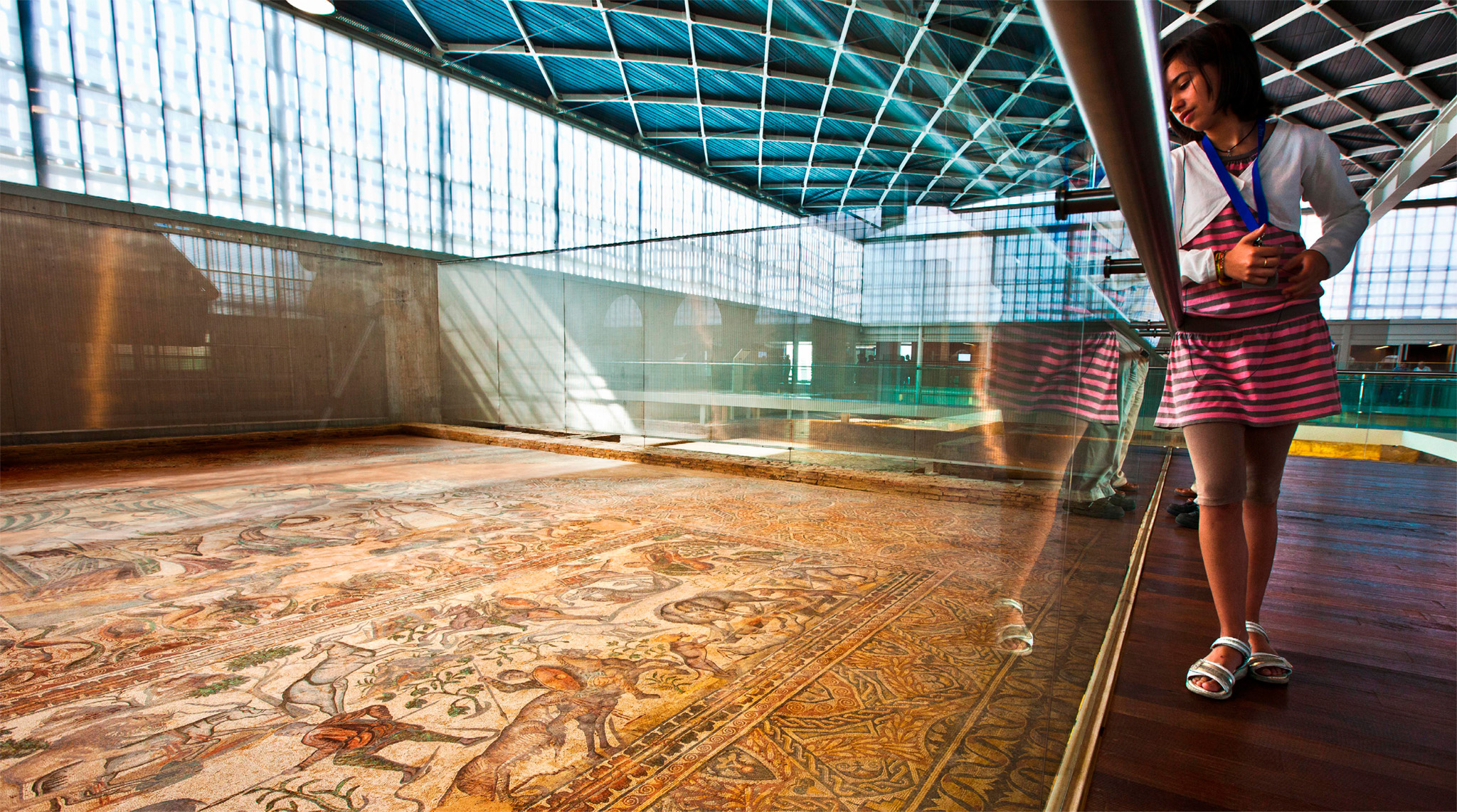
t The Villa Romana La Olmeda
This town on the road to Santiago de Compostela is the site of one of Spain’s purest Romanesque churches. The Iglesia de San Martín is the highlight of the town, partly due to a restoration in 1904, leaving the church, dating from 1066, entirely Romanesque in style. The presence of pagan and Roman motifs suggests it may have pre-Christian origins. Nearby, the Iglesia de San Pedro has Renaissance and Gothic sculptures.
Carrión de los Condes, 20 km (12 miles) to the northwest of Frómista, is also on the Camino de Santiago. The frieze on the door of the Iglesia de Santiago depicts not religious figures but local artisans. There are carvings of bulls on the façade of the 12th-century Iglesia de Santa María del Camino. The Monasterio de San Zoilo has a Gothic cloister and now operates as a hotel.
Located at Gañinas, 20 km (12 miles) to the northwest (just south of Saldaña), is the Villa Romana La Olmeda. It contains a number of mosaics, including a notable hunting scene. Finds are displayed in the archaeological museum in the Iglesia de San Pedro in Saldaña.
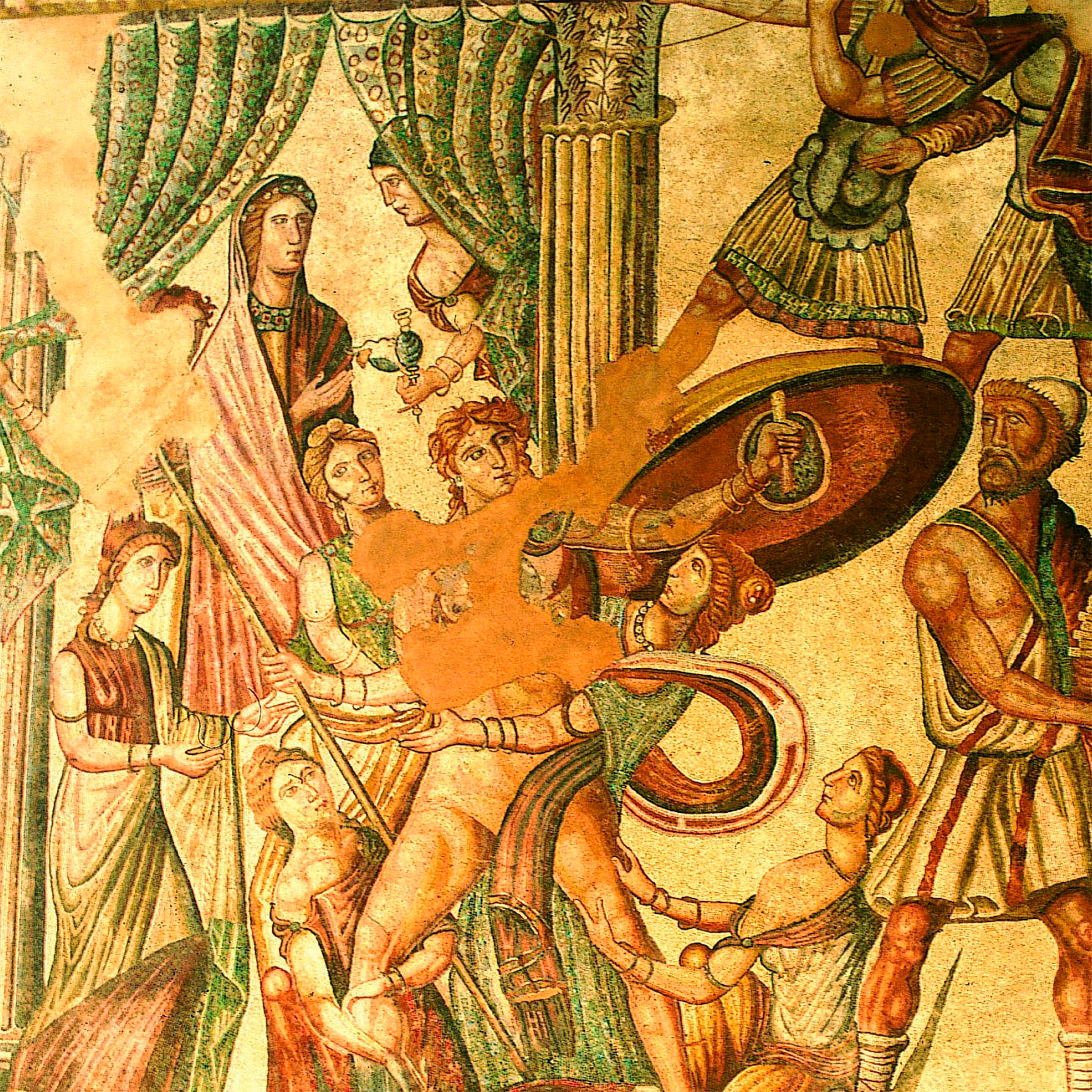
t A detail of the intricate mosaic floor
" '
Villa Romana La Olmeda
⌂ Pedrosa de la Vega § 979 11 99 97 # 10:30am–6:30pm Tue–Sun ¢ 1 & 6 Jan, 24, 25 & 31 Dec
In medieval times, Palencia was a royal residence and the site of Spain’s first university, founded in 1208. The city gradually diminished in importance following its involvement in the failed revolt of the Castilian towns over Carlos I’s regent in 1520.
Although Palencia has since expanded considerably on profits from coal and wheat, its centre, by the old stone bridge over the Río Carrión, remains almost village-like.
The city’s main sight is the cathedral, known as La Bella Desconocida (the Unknown Beauty). It is especially worth a visit for its superb works of art, many the result of Bishop Fonseca’s generous patronage. The retrochoir, exquisitely sculpted by Gil de Siloé and Simon of Cologne, and the two altarpieces, are also noteworthy. The altarpiece above the high altar was carved by Philippe de Bigarny early in the 16th century. The inset panels are by Juan de Flandes, Isabel I’s court painter. Behind the high altar is the Chapel of the Holy Sacrament, with an altarpiece dating from 1529 by Valmaseda. In this chapel, high on a ledge to the left, is the colourful tomb of Doña Urraca of Navarra. Below the retrochoir, a Plateresque staircase leads down to the fine Visigothic crypt.
Baños de Cerrato, 12 km (7 miles) to the south, boasts the tiny Visigothic Iglesia de San Juan Bautista, founded in 661. It is held to be the oldest intact church in Spain. Carved capitals and horseshoe arches decorate the interior.

Hidden Gem
El Cid’s City
Palencia’s cathedral isn’t the only sacred building worth visiting. The Iglesia de San Miguel blends Romanesque and Gothic architecture, and sits on the bank of the River Carrión. It is here that El Cid is said to have married Jimena Díaz.
During the Middle Ages this town grew wealthy from the profitable wool trade, enabling it to commission leading artists, mainly of the Valladolid school, to decorate its churches. The dazzling star vaulting and superb woodwork of the Iglesia de Santa María de Mediavilla, in the centre of town, are evidence of this. Inside, the Los Benavente Chapel is a tour de force, with a colourful stucco ceiling by Jerónimo del Corral (1554), and an altarpiece by Juan de Juni.
The interior of the Iglesia de Santiago is stunning, with a triple altarpiece designed by the Churriguera brothers of Salamanca.
The ancient buildings on Medina de Rioseco’s main street, the Calle de la Rúa, are supported on wooden pillars, forming charming shady porticoes.
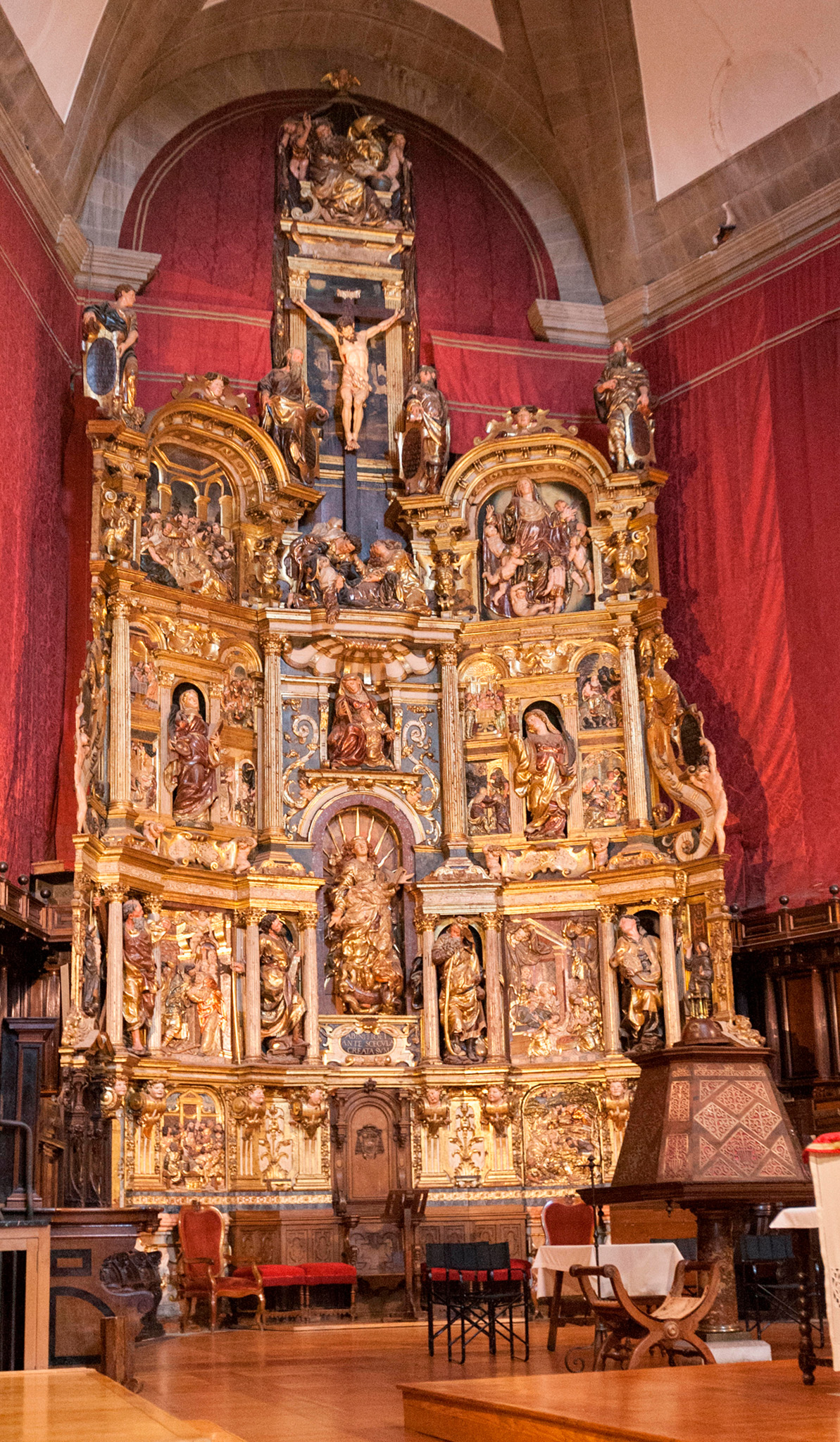
t Altarpiece of the Iglesia de Santa Maria de Mediavilla
EXPERIENCE Castilla y León

Local Fiestas
El Colacho
On the Sunday after Corpus Christi, babies born during the previous year are laid on mattresses in the streets of Castrillo de Murcia.El Colacho – a man dressed as the Devil – then jumps over them to free them from illnesses.
St Agatha’s Day
In Zamarramala, two women are elected as mayoresses on the Sunday closest to 5 February – the day of the patron saint of married women – and ceremonially burn a stuffed figure of a man.
Good Friday
A procession of coloured sculptures, depicting scenes from the Passion, takes place in Valladolid.
Fire-walking
On 23 June in San Pedro Manrique, men walk barefoot over burning embers; it is said only local people can do it without being burned.
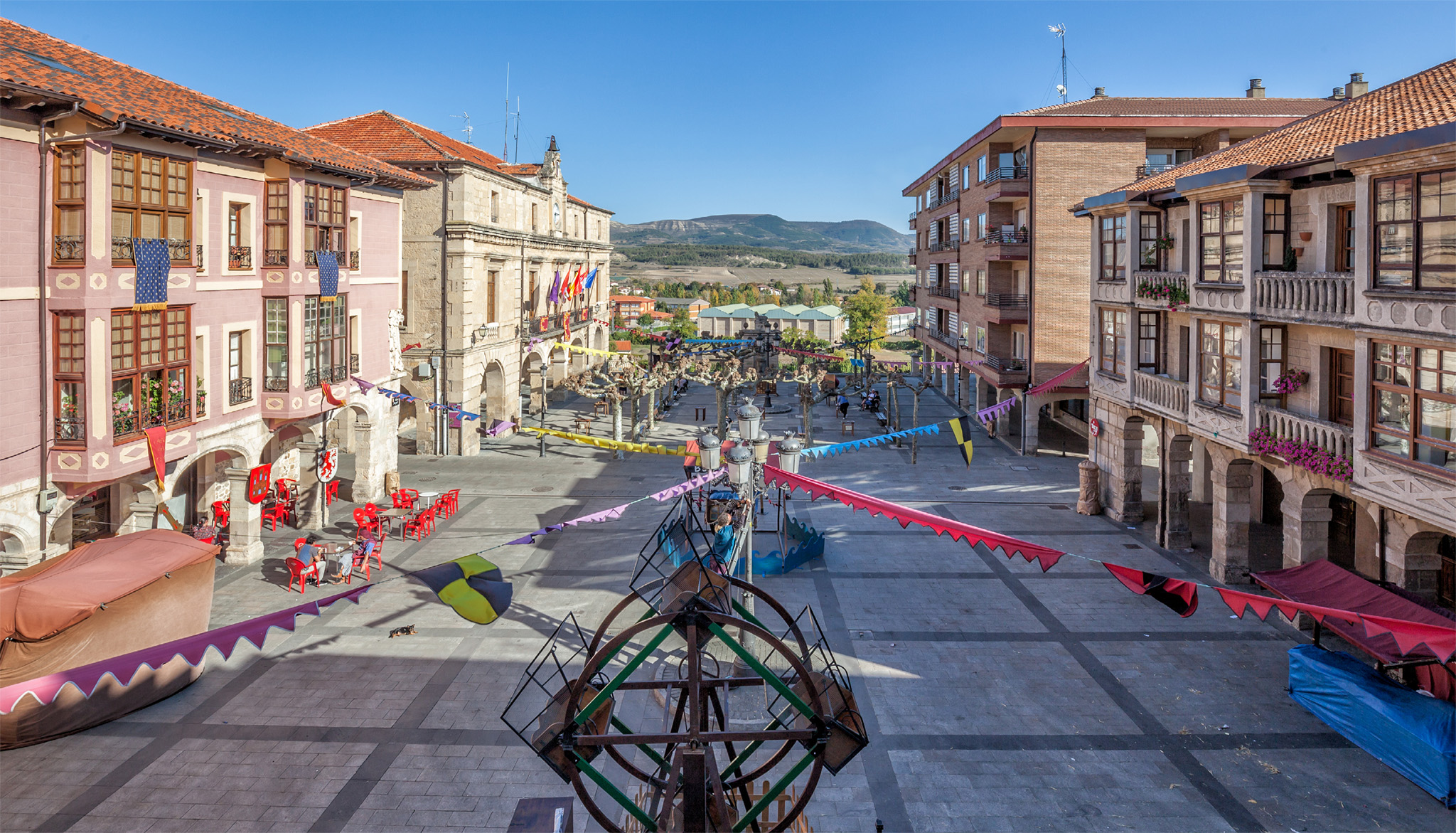
t Bunting strung out across a street in the centre of Briviesca
The walled town of Briviesca, in the northeast of Burgos province, has an arcaded main square and several mansions. The best known of its churches is the Convento de Santa Clara, with its 16th-century walnut reredos carved with religious scenes. In 1387 Juan I of Aragón created the title Príncipe de Asturias for his son, Enrique, in the town. The Santuario de Santa Casilda, outside Briviesca, has a collection of votive objects. Oña, 25 km (15 miles) north of Briviesca, is a pretty town where a Benedictine monastery was founded in 1011. Overlooking a fertile valley, 20 km (12 miles) further northeast, is the little hilltop town of Frías. Its castle overlooks cobbled streets and pretty old houses. Crossing the Río Ebro is a fortified medieval bridge, still with its central gate tower.
At Medina de Pomar, 30 km (20 miles) north of Oña, there is a 15th-century castle, once the seat of the Velasco family. Inside are the ruins of a palace with fine Mudéjar stucco decoration and Arabic inscriptions.

Great View
Parador Paramour
Head up to the parador outside Cervera de Pisuerga, 25 km (15 miles) northwest of Aguilar de Campoo, for a drink . Although the building itself is unremarkable, the view over the Reserva Nacional de Fuentes Carrionas is spectacular (www.parador.es).
Situated between the parched plains of Central Spain and the lush foothills of the Cantabrian Mountains is the old fortified town of Aguilar de Campoo. In the centre of its ancient porticoed main square is the bell tower of the Colegiata de San Miguel. In this church is a mausoleum containing the tomb of the Marquises of Aguilar. Ask at the priest’s house for the key.
Other places of interest are the Ermita de Santa Cecilia, and the restored Romanesque-Gothic Monasterio de Santa María la Real, which has a friendly posada (inn).
Some 6 km (4 miles) south, at Olleros de Pisuerga, is a church built in a cave. From the parador at Cervera de Pisuerga, there are tours of the Reserva Nacional de Fuentes Carrionas. This is a rugged region overlooked by Curavacas, a 2,540-m (8,333-ft) peak.
Named after the reddish caves situated on its outskirts, Covarrubias stands on the banks of the Río Arlanza. Medieval walls surround the charming old centre with its arcaded half-timbered houses. The distinguished collegiate church (closed Tue) shows the historical importance of Covarrubias: here is the tomb of Fernán González, first independent Count of Castile, and one of the great figures in Castilian history. By uniting several fiefs against the Moors in the 10th century, he started the rise in Castilian power that ensured the resulting kingdom of Castile would play a leading role in the unification of Spain. The church museum contains a beautiful Flemish triptych of the Adoration of the Magi, attributed to the school of Gil de Siloé, and a 17th-century organ.
A short distance east along the Río Arlanza lies the ruins of the 11th-century Romanesque monastery of San Pedro de Arlanza. At Quintanilla de las Viñas, 24 km (15 miles) north of Covarrubias, is a ruined 7th-century Visigothic church. Look out for the reliefs on the columns of the triumphal arch, which depict sun and moon symbols. This suggests that they may be pagan.
Gregorian Plainchant
At regular intervals throughout the day, the monks of Santo Domingo de Silos sing services in plainchant, an unaccompanied singing of Latin texts in unison. The origins of chant date back to the beginnings of Christianity, but it was Pope Gregory I (AD 590–604) who codified this manner of worship. It is an ancient and austere form of music which has found a new appeal with modern audiences. In 1994 a recording of the monks became a surprise hit all over the world.
St Dominic gave his name to the monastery he built in 1041 over the ruins of an abbey destroyed by the Moors. It is a place of spiritual and artistic pilgrimage – its tranquil setting has inspired countless poets.
Others come to admire the beautiful Romanesque cloisters, whose capitals are sculpted in a variety of designs, both symbolic and realistic. The carvings on the corner piers depict various scenes from the Bible and the ceilings are coffered in Moorish style. The body of St Dominic rests in a silver urn, supported by three Romanesque lions, in a chapel in the north gallery. The old pharmacy, which is located just off the cloisters, has a display of jars from Talavera de la Reina.
The Benedictine community holds regular services in Gregorian chant in the Neo-Classical church by Ventura Rodríguez. The monastery offers accommodation for male guests.
To the southwest lies the Garganta de la Yecla (Yecla Gorge), where a path leads to a narrow fissure cut by the river. A suggested walk allows you to cross footbridges over waterfalls and pools. To the northeast, the peaks and wildlife reserve of the Sierra de la Demanda extend over into La Rioja.

t Cloisters of the Monasterio de Santo Domingo de Silos
EXPERIENCE Castilla y León
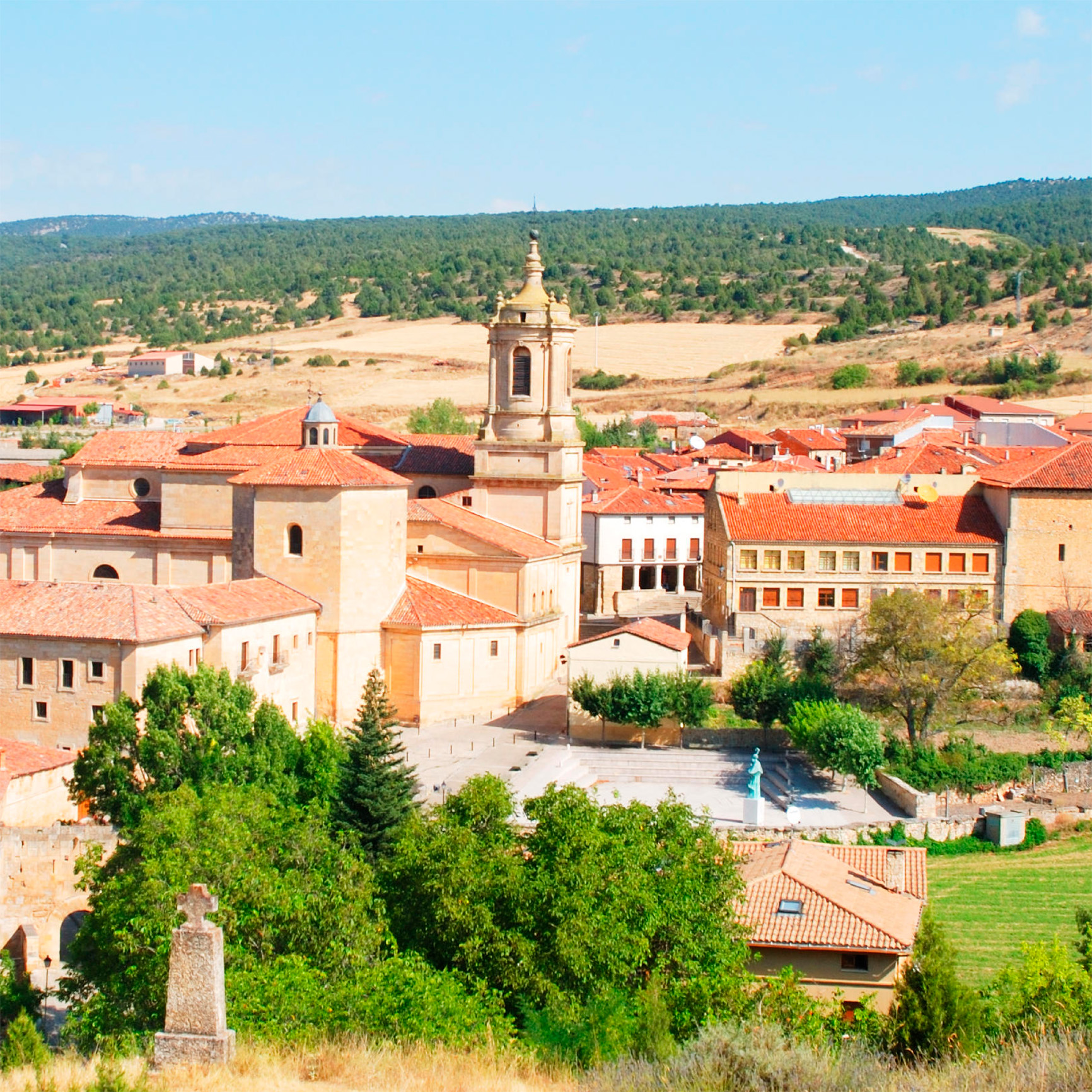
t In a serene setting

t Pantiled houses at Peñaranda de Duero, clustered around the village church
The castle of Peñaranda was built during the Reconquest by the Castilians, who had driven the Moors back south of the Río Duero. From its hilltop site, there are views down to one of the most charming villages in old Castile, where pantiled houses cluster around a huge church. The main square is lined with porticoed, timber-framed buildings. The door of the Palacio de Avellaneda is framed by various heraldic devices, and inside is a patio with decorated ceilings. On Calle de la Botica is a 17th-century pharmacy.
In Aranda de Duero, 18 km (10 miles) to the west, the Iglesia de Santa María has an Isabelline façade.
'
Palacio de Avellaneda
⌂ Plaza Condes de Miranda 1 § 947 55 20 13 # 10am–2pm & 4–8pm Tue–Sun
Did You Know?
William Randolph Hearst wanted to rebuild the Palacio de Avellaneda in the US.
The grandiose appearance of this town is largely due to the ambition of the notorious first Duke of Lerma, Felipe III’s favourite and a corrupt minister from 1598 to 1618. He misused vast quantities of Spain’s new-found wealth, acquired from the New World, on new buildings in his home town – all strictly Classical in style, in accordance with prevailing fashion. At the top of the town, the Palacio Ducal, built in 1605 as his residence, has been transformed into a parador.
There are good views over the Río Arlanza from the archways near to the Convento de Santa Clara and also from the Colegiata de San Pedro church, which has a bronze statue of the Duke’s uncle.
Castilla y León’s smallest provincial capital stands on the banks of the Río Duero. Soria’s stylish, modern parador is named after the poet Antonio Machado (1875–1939), who wrote in praise of the town and the surrounding plains. Many of the older buildings are gone, but among those remaining are the imposing Palacio de los Condes de Gómara, and the Concatedral de San Pedro, both built in the 16th century.
The Museo Numantino, opposite the municipal gardens, displays a variety of finds from the nearby Roman ruins of Numantia and Tiermes. Across the Duero is the ruined monastery of San Juan de Duero, with a 13th-century cloister of interlacing arches.
North of Soria are the ruins of Numantia, whose inhabitants endured a year-long Roman siege in 133 BC before defiantly burning the town and themselves. To the northwest is the Sierra de Urbión, a range of pine-clad hills with a lake, the Laguna Negra de Urbión.

t Roman pottery exhibited at the Museo Numantino in Soria
"
Museo Numantino
⌂ Paseo del Espolón 8 § 975 22 13 97 # Jul–Sep: 10am–2pm & 5–8pm Tue–Sat, 10am–2pm Sun; Oct–Jun: 10am–2pm & 4–7pm Tue–Sat, 10am–2pm Sun
The most interesting sight in this small, attractive city is the cathedral. Although it is mostly Gothic (dating from 1232), the tower is Baroque (1739). Its treasures include a Juan de Juni altarpiece and the tomb of the founder, San Pedro de Osma. The museum here has a valuable collection of illuminated manuscripts and codices.
Porticoed buildings line the streets and the Plaza Mayor, and storks nest on the Baroque Hospital de San Agustín.
Overlooking the Río Duero at Gormaz, 12 km (7 miles) south, is a massive castle that has 28 towers. There are also medieval fortresses still standing at Berlanga de Duero, 20 km (12 miles) further southeast, and at Calatañazor, 25 km (16 miles) northeast of El Burgo de Osma, near to where the Moorish leader al Mansur was killed in 1002.
Situated at the confluence of the rivers Jalón and Arbujuelo, Medinaceli was the site of the Celtiberian town known as Ocilis. Only a triumphal arch remains of Roman Ocilis, perched on a high ridge over the Río Jalón. Built in the 1st century AD, it is the only one in Spain with three arches. It has been adopted as the symbol for ancient monuments on Spanish road signs.
On the Madrid–Zaragoza road is the 12th-century Cistercian Monasterio de Santa María de Huerta. It includes a 13th-century Gothic cloister and the superb, crypt-like Monks’ Refectory, with pointed arched windows.
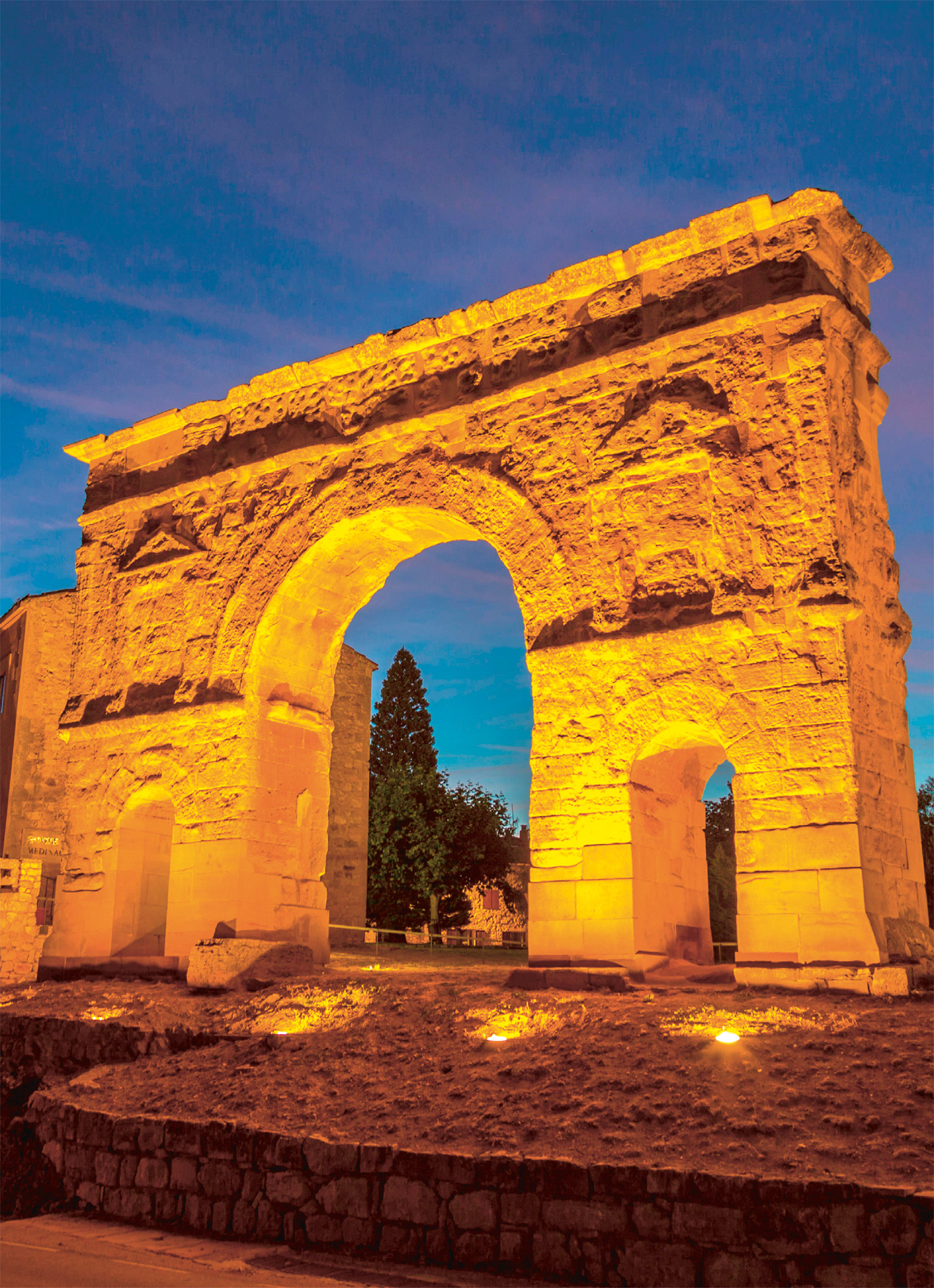
t The triumphal Roman arch in Medinaceli, lit up at night
"
Monasterio de Santa María de Huerta
# 9:15am–1:15pm & 4–6:15pm daily ¢ 24 Aug ∑ monasteriohuerta.org
EXPERIENCE Castilla y León
|
Stay Hotel Medina Salim A modern building incorporating the town’s old walls houses this boutique hotel. Head here for great views and the spa. ⌂ Calle del Barranco 15, Medinaceli # hotelmedinasalim.com ¡¡¡ Parador de Soria This modern hotel offers fabulous views over the town and countryside below. The bathrooms are particularly swanky. ⌂ Parque del Castillo, Calle Fortún López s/n ∑ parador.es ¡¡¡ |
